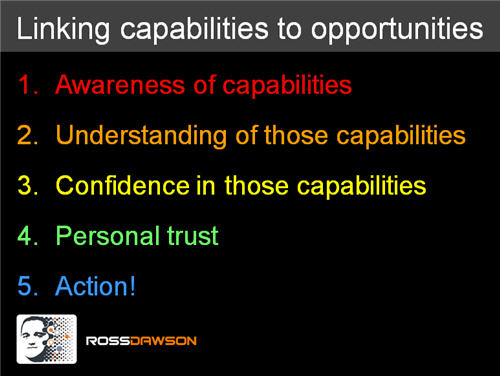The 5 elements that enable expertise networks to flourish
Last week I gave a keynote at an internal conference of a large technology services firm that has recently acquired another firm. The conference brought together senior executives and managers from the two organizations so they could get to know each other and plan how they would work together with existing and new clients.
A significant part of my role was to provide a highly upbeat, optimistic, engaging perspective on the future of business. However I also wanted to address the specific issues they would be encountering in combining their capabilities.
Many years ago when I was working with a large law firm to help them develop their client relationship and cross-selling capabilities, I created a simple framework, shown below.
The fundamental issue for any significant professional firm is to match the best possible capabilities in the organization with the relevant opportunities for value creation at their clients.
This begins at the interface with the client. Whoever has any interaction with the client, including the relationship leader and relationship team, has responsibility to identify and bring to the client the most relevant capabilities of the firm. However there are 5 key steps that are required for that to happen.

1. Awareness of capabilities
The relationship team of course needs to be aware that those capabilities exist. In a large, complex firm simply knowing what resources and expertise is available can be a challenge.
2. Understanding of those capabilities
After awareness, professionals need to understand where those capabilities can be applied, and how to explain them to clients sufficiently well for them to want to take things further. A variety of networking and educational initiatives can help improve both awareness and understanding of organizational capabilities.
3. Confidence in those capabilities
Even after awareness and understanding of capabilities, often the stumbling block is lack of confidence in those capabilities, and a fear of jeopardizing the client relationship by bringing in sub-standard services. Insufficient confidence more often comes from simple lack of knowledge rather than negative impressions. However without evidence to support confidence in capabilities, people will often avoid bringing in other professionals. The key action is in building experience across domains, so managers can develop confidence.
4. Personal trust
Even with these other elements in place, professionals will not reach out unless they believe the people they are bringing in will be good, collaborative players in the team, and be a pleasure to work with.
5. Action!
Finally, action is required. In many cases all of the above elements are in place, yet the best available resources are not brought in for the lack of picking up a phone, sending an email, or otherwise reaching out.
Once these barriers are understood, there are of course many possible initiatives to build internal networks and address each of these critical elements.
There is no perfectly networked firm. However those organizations that can consistently work on improving their performance on these 5 elements will drive substantially higher performance.
